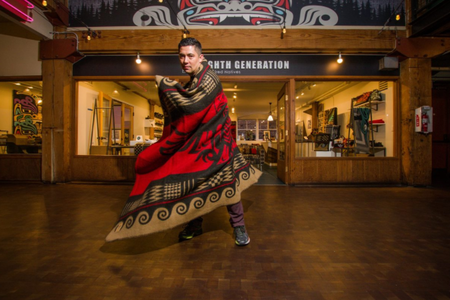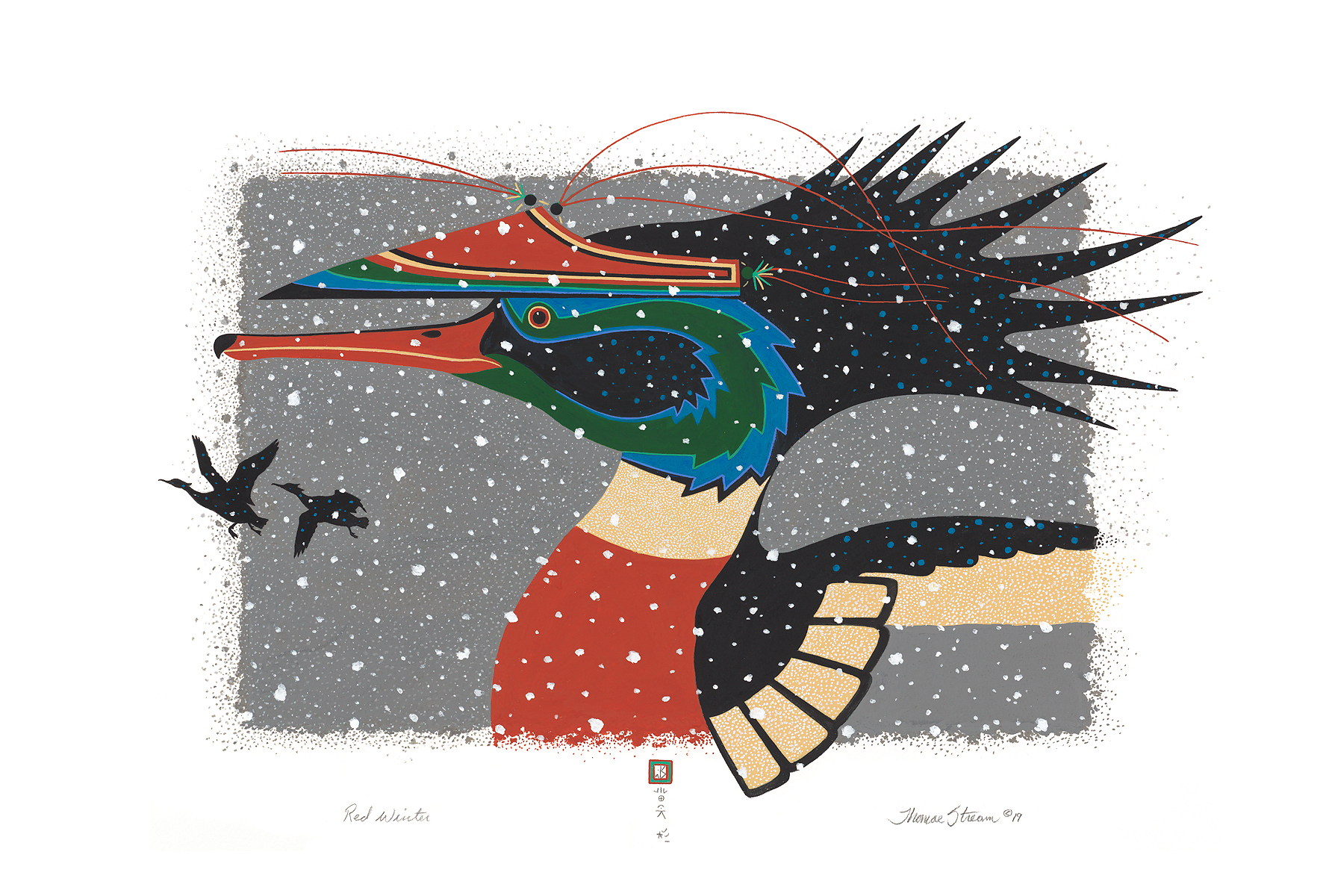
Thomas Stream: Winter
Birds wearing hats — it’s not something commonly seen in nature, but after viewing the current exhibit at Stonington Gallery, you may wonder why milliners haven’t considered the avian market. In Winter, contemporary painter Thomas Stream (Sun’aq Aleut) outfits brightly hued birds in Aleutian hunting hats, visors that are as triangular and pointy as beaks. Traditionally made of steam-bent wood, the hats were designed to shade a hunter’s face and funnel animal sounds into the ears while fishing from a kayak. The visors were also believed to connect the hunter spiritually with the prey. When placed on the heads of jays, grebes, kingfishers and puffins, the hats’ geometry makes the birds appear better protected, more streamlined and decidedly jaunty. –B.D.
If you go: Thomas Stream at Stonington Gallery, through Nov. 30. (Free)
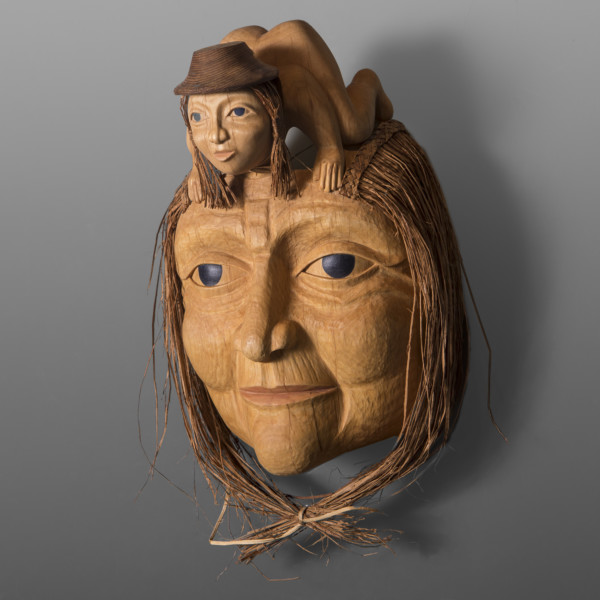
Carol Young Bagshaw: Reflection
Since 1989, Steinbrueck Native Gallery has showcased contemporary work by Native artists from the Northwest Coast, Alaska and the Arctic. Reflection, a poignant solo show of work by wood carver Carol Young Bagshaw (Tsiij git’anee Haida), reveals the artist’s immense talent and personal vision. Having prepared for this exhibit at Steinbrueck Native Gallery for five years, Bagshaw died of lung cancer just weeks before the show opened this month. The work is an apt tribute to her creative life, with many pieces featuring carved images of strong women. But whether depicting a grandmother moon, a frog elder, an otter mother, a medicine woman or Haida wolf, Bagshaw gives her characters a subtle smile — just barely lifting up at the corners of the mouth — that imbues each piece with an uncanny sense of sly wisdom, a larger way of knowing. –B.D.
If you go: Reflection at Steinbrueck Native Gallery, through Nov. 30. (Free)
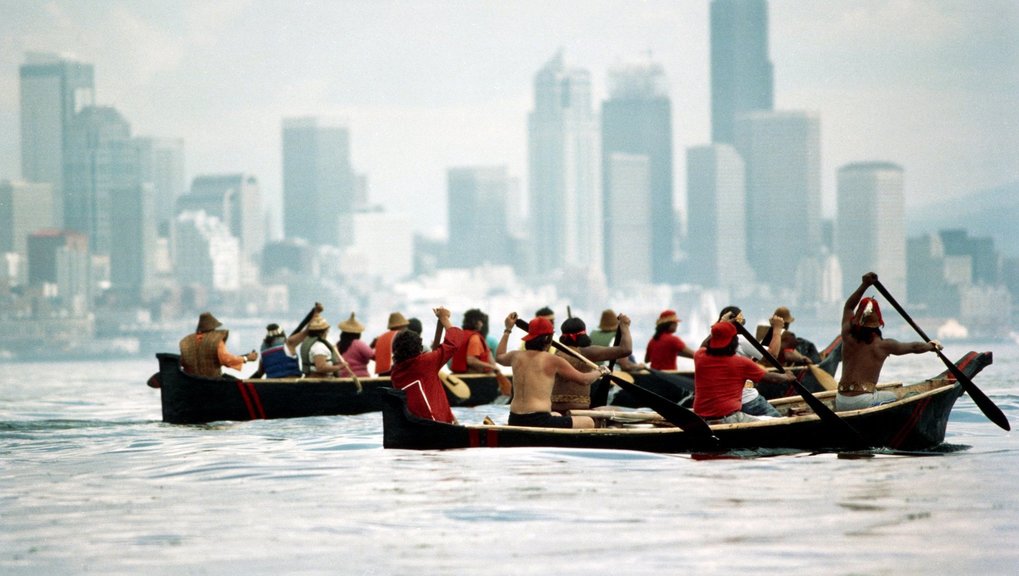
Ancestral Journeyz of Coastal Voices
As part of the centennial celebration of Washington state in 1989, Emmett Oliver (Quinault) kicked off the Canoe Journey, a now yearly cultural celebration in which various tribes undertake a canoe voyage to other communities on their way to a host Nation. At SOIL gallery, a group show honors decades of canoe journeys and interconnections with paintings, carvings, drums, regalia, clothing, collage, baskets, paddles and much more work by roughly a dozen artists from Northwest tribes, including Peter Boome (Upper Skagit) and Katherine Arquette (Muckleshoot, Duwamish and Suquamish tribes). The show also doubles as a market and education center, with artists offering teaching sessions on Saturdays. This Saturday, Ann Penn-Charles (Quileute) will talk about the importance and history of the canoe journey. –M.V.S.
If you go: Ancestral Journeyz of Coastal Voices, SOIL Gallery, through Nov. 30 (free). Today’s Quileute Canoe Journey Stories, Nov. 30, 2 - 4 p.m..
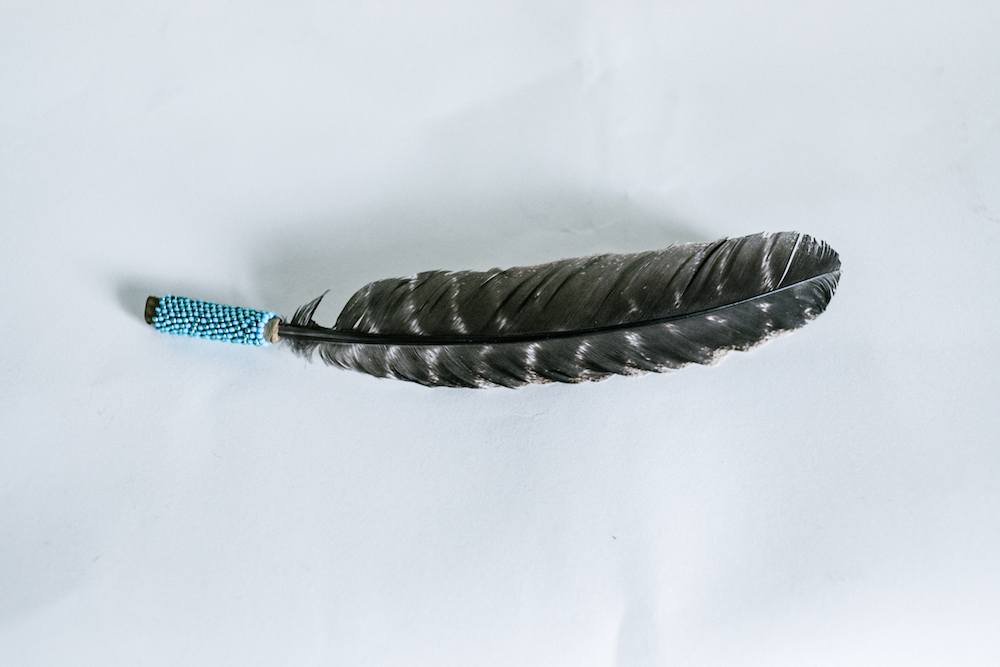
We’re Still Here
In an intricate gray-and-blue pencil drawing by Benjamin E. Wind Spirit Bill (Pit River/Paiute), the charcoal-hued rock surroundings are sparse — which draws the viewer closer to the mysterious cerulean blue of rushing waterfalls. The untitled drawing is one of the artworks included in We’re Still Here, a multimedia exhibition featuring work made by members of Chief Seattle Club, the Pioneer Square-based nonprofit dedicated to serving American Indians and Alaska Natives. In addition to offering food, medical support and legal assistance, the club has an art-making space where these remarkable pieces — beadwork, woodwork, paintings, drawings and linocuts — were created. Lean in to see the intricately beaded figurine by Louisa (LouAnne) Olebar (Ka:’yu:‘k’t’h'/Che:k:tles7et’h’ First Nation), who was taught the craft by her mother and grandmother, and don’t miss the photos by Lloyd Dalton (Haida/Tsimpsian), whose mysterious purple-hued reflection-shot of the Space Needle imbues the icon with new depths. –M.V.S.
If you go: We’re Still Here: An Art Showcase from Members of Chief Seattle Club, Seattle Public Library Level 8 gallery, through Dec. 15. (Free)
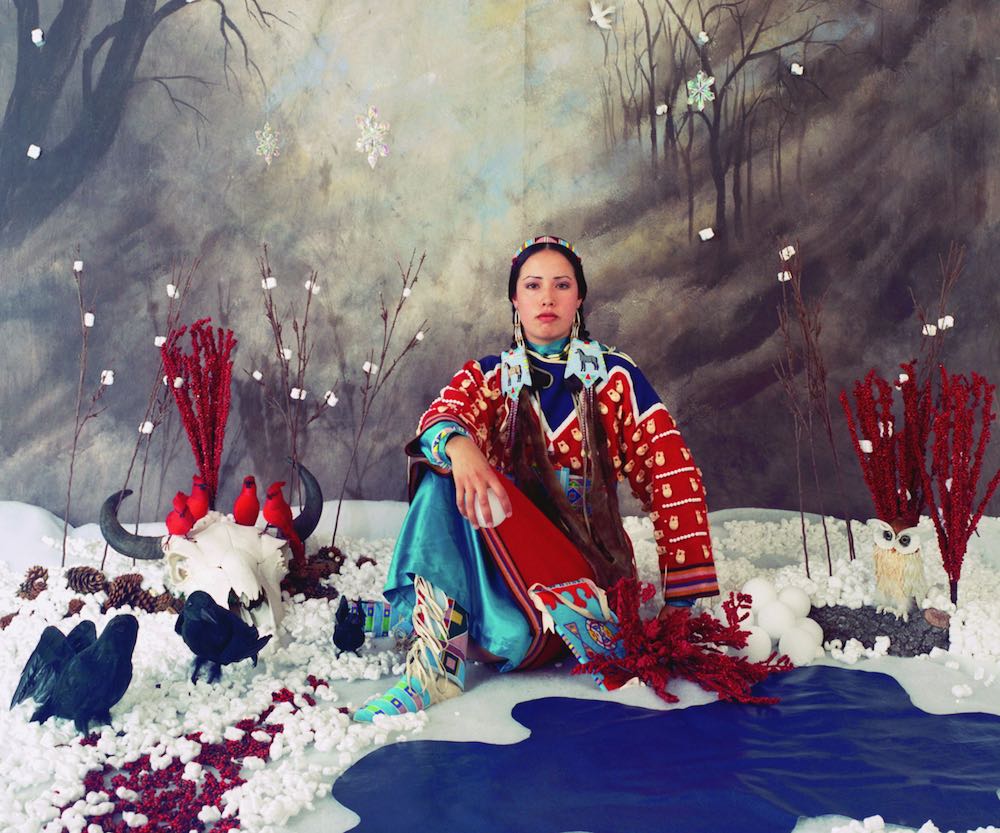
Native Portraiture at Tacoma Art Museum and You Are on Indigenous Land at Seattle Art Museum
Native art populates the permanent collections of our city art museums, and both are currently showcasing contemporary work in special exhibits, too. At the Tacoma Art Museum, Native Portraiture: Power and Perception examines how Native artists shatter stereotypical depictions of Native Americans. A highlight is the four-part photo series “Four Seasons” by Portland-based artist Wendy Red Star, who was raised on the Apsáalooke (Crow) reservation in Montana. Her polychromatic self-portraits — full of inflatable animals and AstroTurf — are witty rebuttals of old clichés.
The photographic series will also be on view at the Seattle Art Museum starting in early December, when the museum switches out some works in its semi-permanent exhibition You Are on Indigenous Land: Places/Displaces. That’s good news/bad news, as it means this week is your last chance to see Vancouver Island (Kwakiutl) artist David Neel’s arresting silkscreen print “Trial of Tears,” a collage of images referencing Native land claims in British Columbia, as well as the four-part series “Desecration,” by Northwest artist John Feodorov (Navajo), who darkly depicts environmental dangers on Navajo rugs. –M.V.S.
If you go: Native Portraiture: Power and Perception, Tacoma Art Museum, through March 3, 2020 ($18). You Are on Indigenous Land: Places/Displaces, Seattle Art Museum, through June 28, 2020. (Pay what you can)
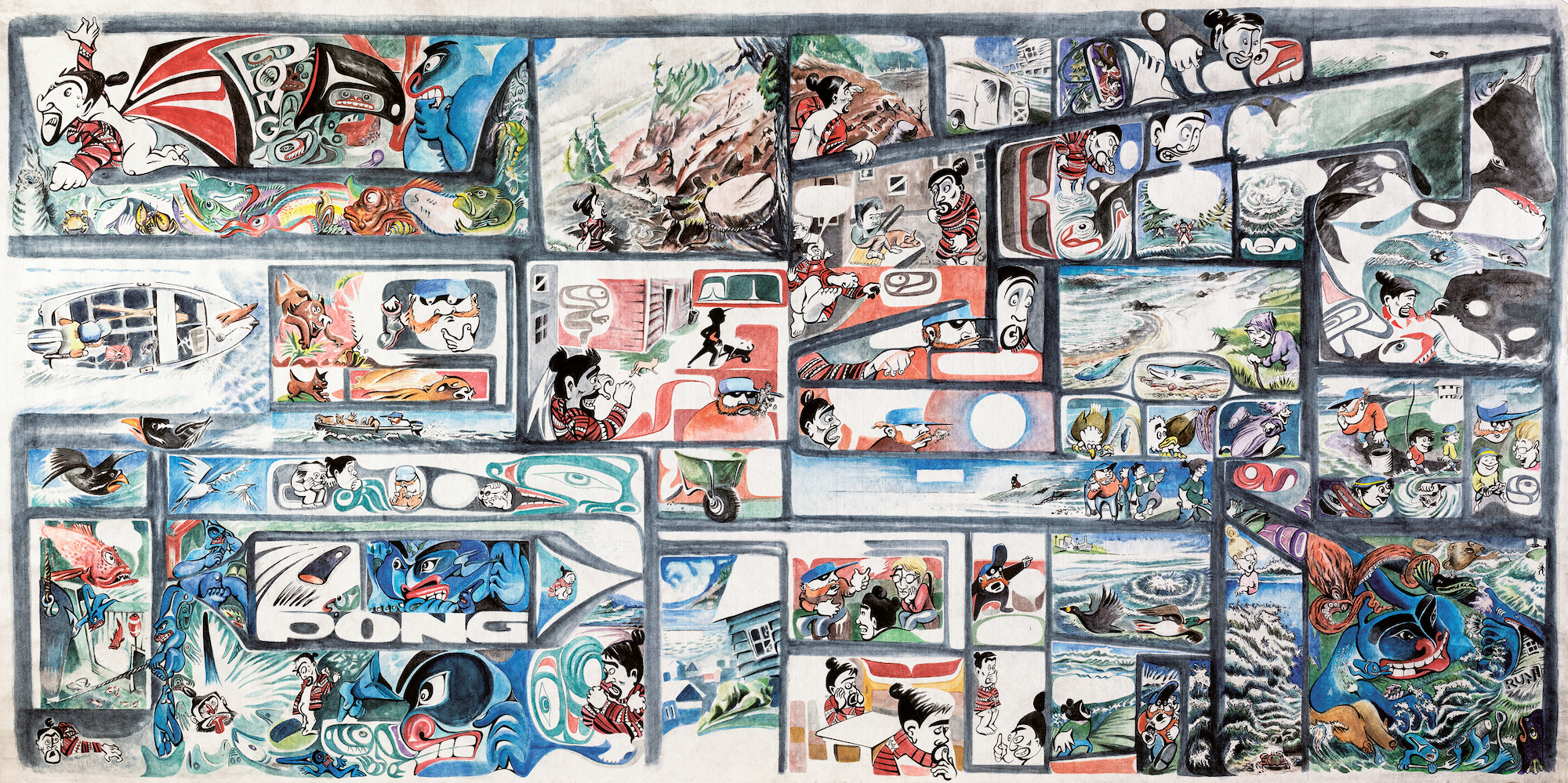
Michael Nicoll Yahgulanaas: Carpe Fin
Do you know Haida Manga? A style of cartooning that marries art forms from around the North Pacific rim, Haida Manga blends the geometric formline patterns and storylines of Northwest Indigenous art with the dynamic adventurism of the hugely popular Japanese comics (not to mention Chinese brush strokes and American Pop Art). The “father” of Haida Manga is Michael Nicoll Yahgulanaas (Haida Gwaii), who Seattle Art Museum recently commissioned to create a large-scale example of the form. The result is Carpe Fin, a stunning 6-by-9-foot watercolor mural on six panels of mulberry paper (handmade in Japan). The tale is a modern update on the Salish story of a hunter who takes to the seas to try to feed his starving community — only to become so efficient at killing he wipes out the source of food. What looks from afar to be a tornado of color and unusually shaped comics panels crystallizes into untold captivating scenes when you step closer. Most of the story is told graphically — aside from a few bits of “shouted” text, such as “EVERYONE BACK TO THE CANOE!” In a video accompanying the piece, an affable Yahgulanaas explains that Carpe Fin means “seize the end.” In other words, pay close attention to the endings of cultures, because history tends to repeat. –B.D.
If you go: Carpe Fin at Seattle Art Museum, through Nov. 1, 2020. ($20 - $30)
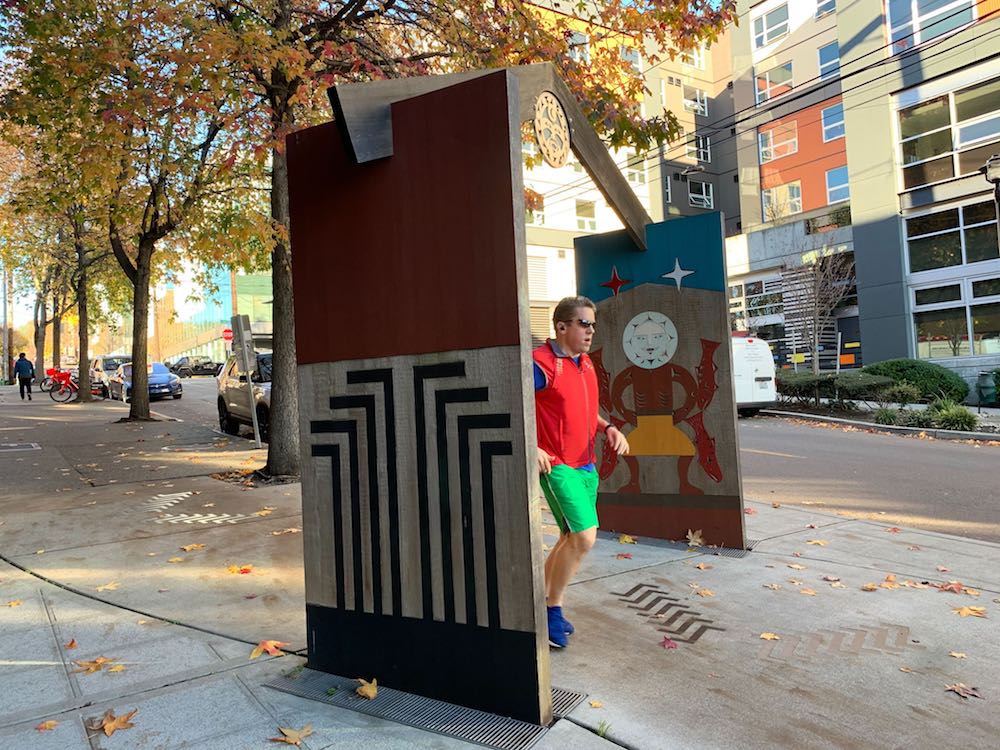
Visible on Ancestral Lands: Coast Salish Public Art Works
Northwest Native artists have contributed dozens of works to the local public art landscape. You’ve likely encountered them in your daily comings and goings, but now you can learn more about their origins, and create your own art walk, thanks to “Visible on Ancestral Lands: Coast Salish Public Art Works in King County.” Created by Crisca Bierwert, an affiliate associate professor of anthropology at the University of Washington, with help from 4Culture and local indigenous leaders, the interactive online map was released in June. It documents 42 Native artworks across Puget Sound, and includes stories from the artists about each piece and its connection to the original peoples inhabiting our region.
Many Native artists have contributed multiple pieces, including Susan Point (Musqueam), whose hand-carved red plaster mural “Four Corners” adorns a wall at North Seattle College. Quinault artist Marvin Oliver, who died earlier this year, contributed more than five installations to the public artscape. Look for his piece “Spirit of Washington” (1992), a cast bronze sculpture of an orca whale’s dorsal fin, which sits on a boulder behind the Seattle Public Library’s Columbia City branch. Standing 16 feet tall, the piece features bold lines in a pattern commonly found on traditional Salish bowls and dark oceanic tones that form the figure of a person. In Queen Anne, find “Snoqual (Moon) the Transformer” (2012), a sculpture by Roger Fernandes (Lower Elwha Band) that captures the Snoqualmie Tribe’s story of the moon’s birth and how the moon altered the Earth to create Snoqualmie Falls. The piece illustrates the clash between traditional Native ways (represented by two standing cedar panels) and colonialism (represented by a metal wrap), and features two arching boards that suggest a roof or portal. To pass through it is to walk through ancient Northwest history into the present moment. –A.P.F.
If you go: Create your own art walk with the Visible on Ancestral Lands: Salish Public Artworks in King County map.
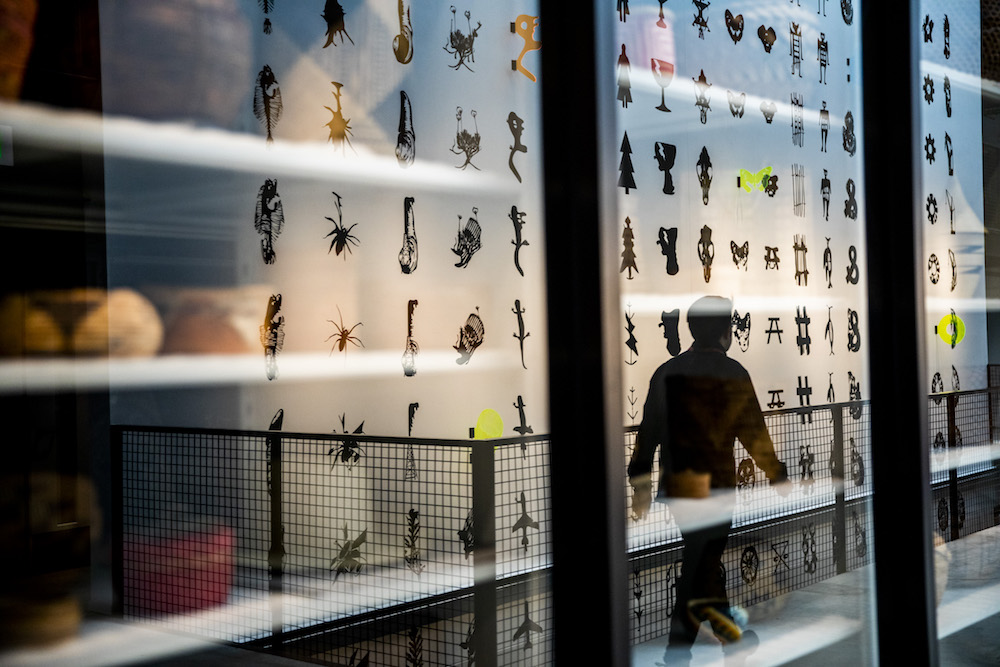
Burke Museum: Northwest Native Art Gallery
The Burke Museum has been long heralded for its natural history collection, but the brand new building is also a showcase for contemporary Native American artists, whose work complements and draws from the huge array of Indigenous artifacts. In the lofty new lobby, visitors are greeted by a 10-foot tall glass and bronze sculpture created by artists Brian Perry (Port Gamble S’Klallam), Anthony Jones (Port Gamble S’Klallam), Preston Singletary (Tlingit) and David Franklin. The human figure, titled “Weaver’s Welcome,” honors the Salish tradition of carving welcome figures on posts inside longhouses on the shores of the Salish Sea. Stepping farther into the museum, look for artist RYAN! Feddersen’s (Okanogan /Arrow Lakes) three-story mural adorning the open stairway, depicting a hieroglyphic language she created based on artifacts in the museum.
Find more of Feddersen’s work in the Northwest Native Art Gallery, where she showcases a humorous take on Andy Warhol’s famous soup can: a colorful, wool, kelp and sinew basket highlighting the artistic legacy of the many artists of the “Feddersen” name. Also in the gallery, other contemporary artists share their reflections on the meaning of artistic heritage — including Betty Pasco (Suquamish), whose woven blanket incorporates traditional Salish iconography; Nicholas Galanin (Tlingit/Unangax), whose carved silver bracelet cuff honors Indigenous water protectors and activists fighting for clean water; and Alison Marks (Tlingit), who offers a formline take on the Fremont Troll, a figure that struck her as a child upon arriving in Seattle from Alaska. And when you've finished imbibing the art, stop by the cafe to sample fresh takes on Indigenous foods by Off the Rez. –B.D. and M.V.S.
If you go: Burke Museum, 10 a.m. - 5 p.m. daily. ($14 - $22)
Holiday shopping with Native arts
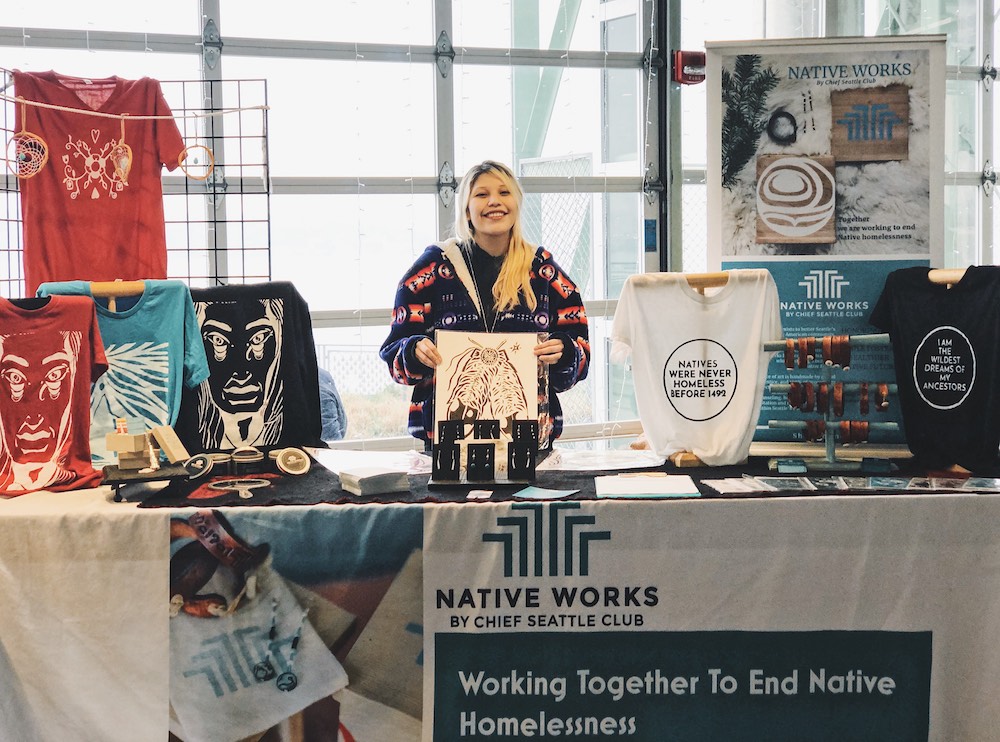
>> The Duwamish Longhouse and Cultural Center is open year-round, and this weekend hosts the annual Native art market and gift fair, featuring artists and local vendors showcasing paintings, prints, drums, bead work and wood carvings — plus hot coffee and fry bread. Open Nov. 29 - Dec. 1 and Dec. 13 - 15, 10 a.m. - 5 p.m.
>> It was big news back in 2016 when Eighth Generation, a hub for Native-designed art and lifestyle products, opened its brick-and-mortar store at Pike Place Market. Three years later, Eighth Generation remains one of Seattle’s go-to shops for Native-designed prints, phone covers, jewelry, T-shirts, gorgeous wool blankets and all manner of other arts and crafts that are — as founder Louie Gong says — made by “inspired Natives,” as opposed to “inspired by” Native culture. Open daily 10 a.m. - 5 p.m. (closed Nov. 28).
>> Located near the northern edge of Pike Place Market’s new Marketfront building, Native Works is back for the holidays. The temporary stall (which benefits Chief Seattle Club) will feature the online shop’s bestsellers, including T-shirts, beaded jewelry and leather bracelets stamped with "home" in the Lushootseed language, all crafted by apprentices at the Chief Seattle Club, as well as a “market special” candle in lavender, sweetgrass and sage scents. Open Wed. - Thurs., 10 a.m. – 5 p.m. (closed Nov. 28 and 29).
>> Seattle Art Museum's SAM Shop showcases art and jewelry by Native artists from several tribes, including carved and painted wooden wall plaques by Squamish and Penelakut artists, silver and beaded bracelets by Coast Salish artists, carved cedar pins and paddles by Firewoman Studio (Tsalagi/Salish/Dutch), and extremely cool basketballs adorned with traditional formline designs by Trickster, a Native design company based in Juneau, Alaska. Open Wed. - Sun., 9 a.m. - 5 p.m. (closed Nov. 28).
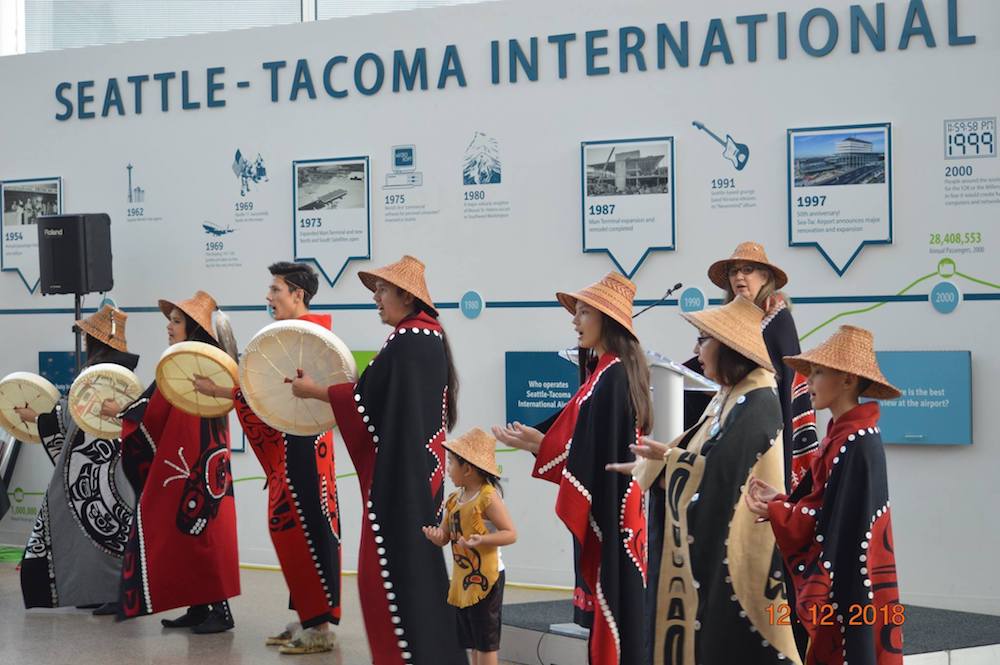
>> Travelers traversing what is sure to be a crowded Seattle-Tacoma International Airport this week may find some solace by visiting the Sea-Tac Sacred Circle Gallery and Gift Shop. The store, which opened earlier this year and is operated and staffed by the nonprofit United Indians of All Tribes Foundation, is the airport’s first Native American-owned retail shop, and offers Native-designed items, including jewelry, clothing and gifts. Open daily 7 a.m. - 7 p.m. For those staying put in Seattle: the foundation also operates a Sacred Circle Gallery and Gift Shop at the Daybreak Star Indian Cultural Center in Discovery Park. Open Wed - Fri, 9.30 a.m. - 5 p.m.
>> Dedicated to preserving and enhancing the cultural legacy of the Tulalip tribes, the expansive Hibulb Cultural Center features temporary and permanent exhibits, a longhouse, an archaeological repository and a 50-acre nature preserve. Currently on view (through Dec. 29) is Interwoven History: Coast Salish Wool, an exhibit that traces the region’s rich history of textile weaving from the past (including a garment made with fur from the extinct woolly dog) right up through the present. The gift shop is populated with arts and crafts made by Northwest Native artists, including those represented by Trickster, Sister Sky and Boma. Open Tues. - Fri., 10 a.m. - 5 p.m., Sat. - Sun., noon - 5 p.m. (Closed Nov. 28 and 29)
>> Located on the Port Madison Indian Reservation, steps from Chief Sealth’s grave, the Suquamish Museum and grounds showcase the integral role the Suquamish Tribe played in the origins of Seattle — and the Indigenous history long before settlers arrived. The permanent exhibit, Ancient Shores – Changing Tides, uses artifacts from the community to chronicle the tribe’s steady presence on the shores of the Salish Sea, and integrates Lushootseed, the language spoken by many Coast Salish peoples. The museum gift shop features work by many Suquamish tribal members, including wool and cedar weavers, beadworkers, wood and bone carvers and painters. Open daily 10 a.m. - 5 p.m. (Closed Nov. 28)
Get the latest in local arts and culture
This weekly newsletter brings arts news and cultural events straight to your inbox.



